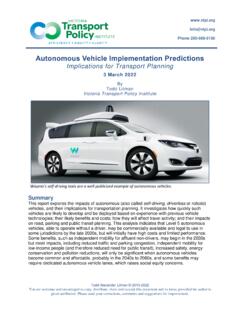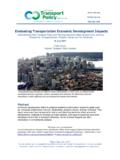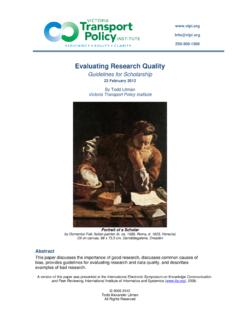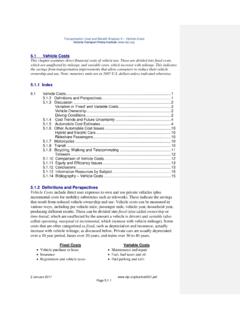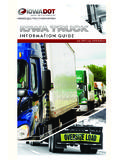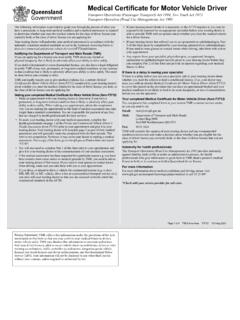Transcription of Evaluating Accessibility For Transport Planning
1 250-508-5150. Evaluating Accessibility for Transport Planning Measuring People's Ability to Reach Desired services and Activities 17 December 2021. Todd Litman Victoria Transport Policy Institute The Brooklyn Bridge provides mobility and access between Manhattan and Brooklyn. Abstract This paper discusses the concept of Accessibility and how it can be incorporated in Transport Planning . Accessibility refers to people's ability to reach desired services and activities, which is the ultimate goal of most Transport activity. Many factors affect Accessibility , including mobility (physical movement), the quality and affordability of Transport options, Transport system connectivity, mobility substitutes, and land use patterns. Accessibility can be evaluated from various perspectives, including a particular group, mode, location or activity.
2 Conventional Planning tends to overlook and undervalue some of these factors and perspectives. More comprehensive analysis of Accessibility in Planning expands the scope of potential solutions to Transport problems. A shorter version of this paper was presented at the th 87 transportation Research Board Annual Meeting ( ), January 2008. Todd Alexander Litman 2007-2021. You are welcome and encouraged to copy, distribute, share and excerpt this document and its ideas, provided the author is given attribution. Please send your corrections, comments and suggestions for improvement. Evaluating Accessibility for transportation Planning Victoria Transport Policy Institute Contents Executive Summary .. 2. Introduction .. 4. Defining Accessibility .. 6. Factors That Affect Accessibility .
3 8. transportation Demand and Activity .. 8. Mobility .. 9. transportation Options .. 10. User Information .. 11. Integration, Terminals and Parking .. 13. Affordability .. 14. Mobility Substitutes .. 15. Land Use Factors .. 16. transportation Network Connectivity .. 20. transportation System Management .. 22. Prioritization .. 23. The Value of Inaccessibility .. 26. Summary of Factors Affecting Accessibility .. 27. Perspectives .. 28. Individuals and 28. 29. Location .. 31. Activity .. 31. Summary .. 31. Evaluating Accessibility .. 32. Optimal Accessibility and Mobility .. 40. Evaluating Automobile 41. Strategies for Improving Accessibility .. 43. Examples .. 46. Best Practices .. 51. 54. References and Resources for More Information .. 56. 63. An automobile is a machine for mobility.
4 A city is a machine for Accessibility .. When people say, location, location, location, they really mean Accessibility , Accessibility , Accessibility .. 1. Evaluating Accessibility for transportation Planning Victoria Transport Policy Institute Executive Summary Accessibility refers to people's overall ability to reach desired services and activities (together called opportunities), and therefore the time and money that people and businesses must devote to transportation . Accessibility is the ultimate goal of most transportation Planning . Several factors can affect this Accessibility : Mobility. The ease of physical movement, and therefore the quality (availability, frequency, speed, comfort, etc.) of travel modes (walking, bicycling, taxies, public Transport , air travel, etc.)
5 Geographic proximity. The distances between destinations, and therefore land use development factors such as development density and mix, which affect these distances. Transport system connectivity. This can include the density of sidewalk, road and public transit networks, and the quality of connections between modes, such as transit station bike parking, and transit connections to airports. Affordability. This refers to the financial costs of travel relative to users' income. Convenience. The ease of obtaining travel information, paying fares and carrying luggage. Social acceptability. The ability to use a mode sometimes depends on its social status. Since Accessibility is the ultimate goal of most transportation activity (excepting the small amount of travel that has no desired destination), Transport Planning should be based on Accessibility .
6 However, conventional Planning tends to evaluate Transport system performance based primarily on motor vehicle travel conditions using indicators such as roadway level-of-service, traffic speeds and vehicle operating costs; other Accessibility factors are often overlooked or undervalued. This tends to favor mobility over Accessibility and automobile Transport over other modes. Planning decisions often involve trade-offs between different forms of Accessibility . For example, wider roads designed to maximize automobile traffic speeds tend to create barriers to walking and bicycling, reducing non-auto access. Similarly, denser development tends to reduce automobile travel speeds and parking supply, but improves walking, bicycling and public transit Accessibility .
7 A new Planning paradigm requires more comprehensive Accessibility analysis. Our ability to evaluate Accessibility is improving as transportation and land use planners develop better tools for quantifying Accessibility impacts, including multi-modal level-of-service indicators, and models which measure the travel distances, travel time and travel costs required by various types of Transport system users to access various types of services and activities. However, Accessibility -based Planning techniques are still new and practitioners are still learning how to apply them to specific decisions. Comprehensive Accessibility analysis therefore requires creativity and judgment to incorporate new Accessibility factors. Table ES-1 lists factors indicates factors that affect Accessibility , how they are currently considered, and potential improvements for more comprehensive Planning .
8 This information can be used to critique and improve Planning . 2. Evaluating Accessibility for transportation Planning Victoria Transport Policy Institute Table ES-1 Summary of Factors Affecting Accessibility Name Description Current Consideration Improvements The amount of mobility and Motorized travel demand is More comprehensive travel Transport access that people would well measured, but other surveys, statistics and analysis Demand choose in specific conditions. modes are not. of travel demands. Automobile Automobile travel speeds, Often considers speed, delay Consider other vehicle impacts travel convenience, and affordability. and parking convenience. including affordability and risk. Transport The quality (speed, More multi-modal evaluation system convenience, comfort, safety, Some models apply (speed, convenience, comfort, diversity etc.))
9 Of Transport options multimodal LOS analysis, but safety, etc.) of walking, (mobility including walking, bicycling, many factors are often bicycling, public transit, taxi options) public Transport , etc. overlooked. and ridehailing, etc. Roadway Density of roadway connections Some models consider network and therefore the directness of roadway connectivity More comprehensive analysis connectivity travel between destinations. impacts on Accessibility . of roadway connectivity. Transport Connectivity for automobiles More integrated analysis of network The degree of integration is well measured other connectivity among non-auto connectivity among Transport modes. modes is often overlooked. modes. Proximity The distances between Usually considered in land (Land Use activities, and therefore use Planning , but less in More comprehensive analysis Factors) development density and mix.
10 Transport Planning . of land use Accessibility . Telecommunications and Consider mobility substitutes Mobility delivery services that substitute Not usually considered in as part of the Transport Substitutes for physical travel. Transport Planning . Planning . Sometimes considered for More comprehensive and Availability of reliable particular modes or integrated information to help User information on mobility and locations, but seldom users navigate Transport information Accessibility options. comprehensive. systems. Automobile operating costs More comprehensive The cost to users relative to and transit fares are usually evaluation of Transport costs Affordability their incomes. considered. relative to users incomes. Transport Whether Transport systems are Apply Transport management system managed to favor higher value strategies to increase system management trips and more efficient modes.

